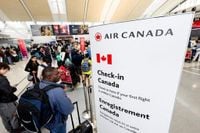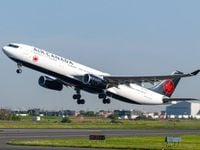On a drizzly August morning in Montreal, picket lines formed outside Air Canada headquarters, their signs reading, “Ground our rights? Ground the planes!” Behind those slogans was a historic labor battle that would ripple throughout Canada’s workforce. More than 10,000 Air Canada and Air Canada Rouge flight attendants, represented by the Canadian Union of Public Employees (CUPE), launched a strike on August 17, 2025, after months of stalled contract talks. Within just 12 hours, the federal government declared their strike illegal, ordering the workers back on the job under Section 107 of the Labour Code. But this time, the union refused to comply.
The defiance was striking. Flight attendants, who had voted an overwhelming 99.7 percent in favor of striking earlier that month, stood their ground. "Members are reminded that it is not a criminal offence to remain on the picket line," a CUPE bargaining update assured. Union leaders, including CUPE president Mark Hancock, made their stance clear: “If it means folks like me going to jail, then so be it. If it means our union being fined, then so be it.” According to The Canadian Press, Hancock even tore up the back-to-work order at a press conference, a symbolic gesture that captured the mood of the picketers who chanted, “Forced to fly? We won’t comply!”
The impact was immediate and widespread. Airline analysts estimated that 3,000 flights were canceled each day, disrupting travel for about 130,000 passengers and costing Air Canada a staggering $43 million per day. The airline, which reported nearly $3 billion in profits the previous year and planned a $300 million stock buyback in 2025, quickly returned to the bargaining table. Other unions joined the rallies, and the U.S.-based Association of Flight Attendants sent a message of solidarity, blaming “corporate greed” for the disruption and calling for an end to poverty wages at Air Canada.
At the heart of the dispute was the issue of unpaid work. For decades, Air Canada flight attendants had only been paid for time when the aircraft doors were closed and the plane was in motion. The hours spent on safety checks, boarding, deplaning, and assisting passengers—sometimes amounting to nearly 14 hours in a shift—went uncompensated. One CUPE member described on Facebook, “As a Rouge flight attendant I once spent nearly 14 hours on duty without the plane ever leaving the ground. We boarded and deplaned passengers three times due to a maintenance issue…I was only paid a little over four hours.”
This pay structure, long considered an industry standard, has come under increasing scrutiny. According to NPR, Delta Air Lines began paying its flight attendants half their hourly rate for boarding time in 2022, a move widely seen as an attempt to stave off unionization. American Airlines and its union soon followed with similar agreements, while United Airlines’ flight attendants recently rejected a contract that included half-pay during boarding, pushing for better terms.
After three days of strike action and mounting public pressure, Air Canada and CUPE reached a tentative agreement on August 20, 2025. The deal addressed the core demand: ground duty pay. Under the proposed contract, flight attendants would receive 50 percent of their hourly wage for 60 minutes of ground time on narrow-body aircraft and 70 minutes on wide-body planes. Those rates are set to rise to 60 percent in April 2026, 65 percent in 2027, and 70 percent in 2028. The agreement also included a 12 percent salary increase in 2025 for most junior attendants and an 8 percent raise for senior staff, with further increases of 3 percent in 2026, 2.5 percent in 2027, and 2.75 percent in 2028. The contract is slated to run until March 31, 2029.
Voting on the new contract began on August 27 and will continue until September 6, 2025, with results expected to be released within a day of the vote’s conclusion. However, not all flight attendants are satisfied. Several told CP24 and Reuters they planned to vote against the deal, arguing that the wage increases and ground duty pay do not go far enough. Should the pay portion of the agreement be rejected, other terms—such as changes to health and pension benefits and vacation time—will remain, while wages will proceed to third-party arbitration.
The government’s intervention in the strike was hardly unprecedented. Since June 2024, Ottawa had issued back-to-work orders eight times to halt or prevent strikes in federally regulated industries, including rail, port, and postal workers. In each previous case, unions complied. But the Air Canada flight attendants’ refusal to return to work marked a turning point. As The Maple reported, “The flight attendants’ refusal to go back ‘sets a precedent for the reality that [Section] 107 is no longer effective, it is effectively dead,’” quoting Canadian Labour Congress president Bea Bruske.
The Supreme Court of Canada has recognized the right to strike as constitutionally protected, a cornerstone for fair collective bargaining. Yet, Section 107 of the Labour Code allowed the government to issue back-to-work orders and impose binding arbitration, often at the expense of workers’ leverage. According to David Moscrop, writing in his Substack column, “The ability of workers to withhold their labour is essential to securing fair deals from employers. Without the threat of losing the labour that makes business possible, employers have little to no incentive to bargain in good faith, or at all.”
Indeed, Air Canada admitted during negotiations that it had relied on the government to force workers back on the job rather than engage in genuine bargaining. The Canada Industrial Relations Labour Board sided with the union, declining to ask the courts to enforce the back-to-work order, reasoning that it would have been “unduly punitive and not conducive to harmonious labour relations and constructive bargaining.”
The broader implications of the strike are still unfolding. The outcome may embolden other unions to challenge back-to-work orders, potentially reshaping labor relations in Canada. The precedent set by CUPE’s resistance could make Section 107 a tool of last resort, rather than a routine response to labor disputes. As Bruske put it, “The best way to deal with it is to remove it entirely because unions, workers, the labor movement has been emboldened by this and we’re not going to turn around.”
For now, Air Canada’s flight attendants await the results of their contract vote, the echoes of their stand reverberating through the country’s labor landscape. The events of August 2025 have already shifted the balance of power at the bargaining table, ensuring that the voices of frontline workers—and their right to strike—can’t be grounded so easily.


